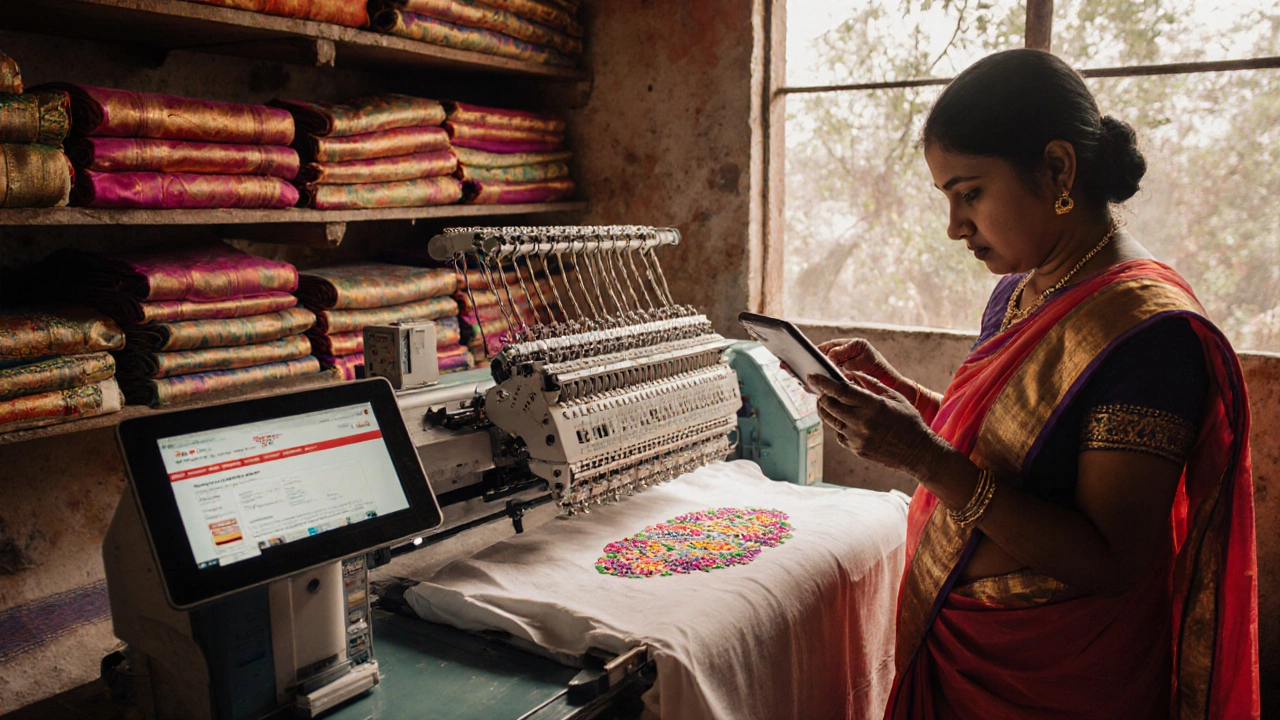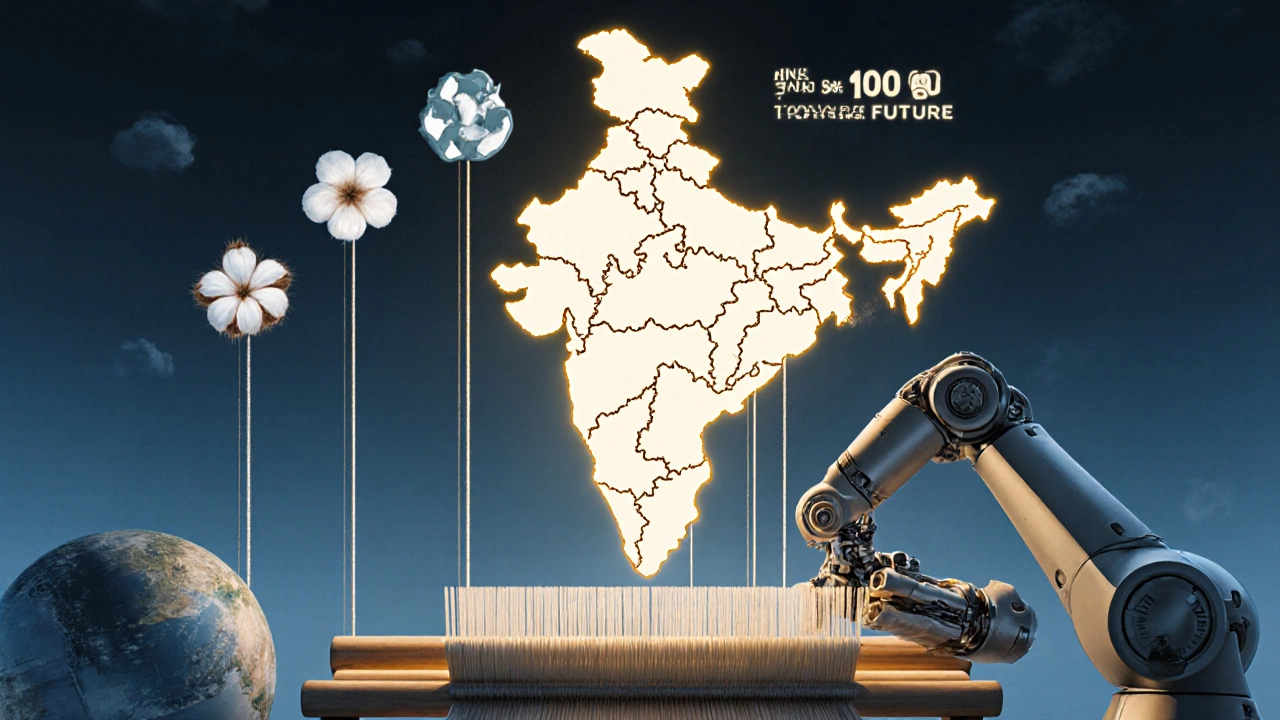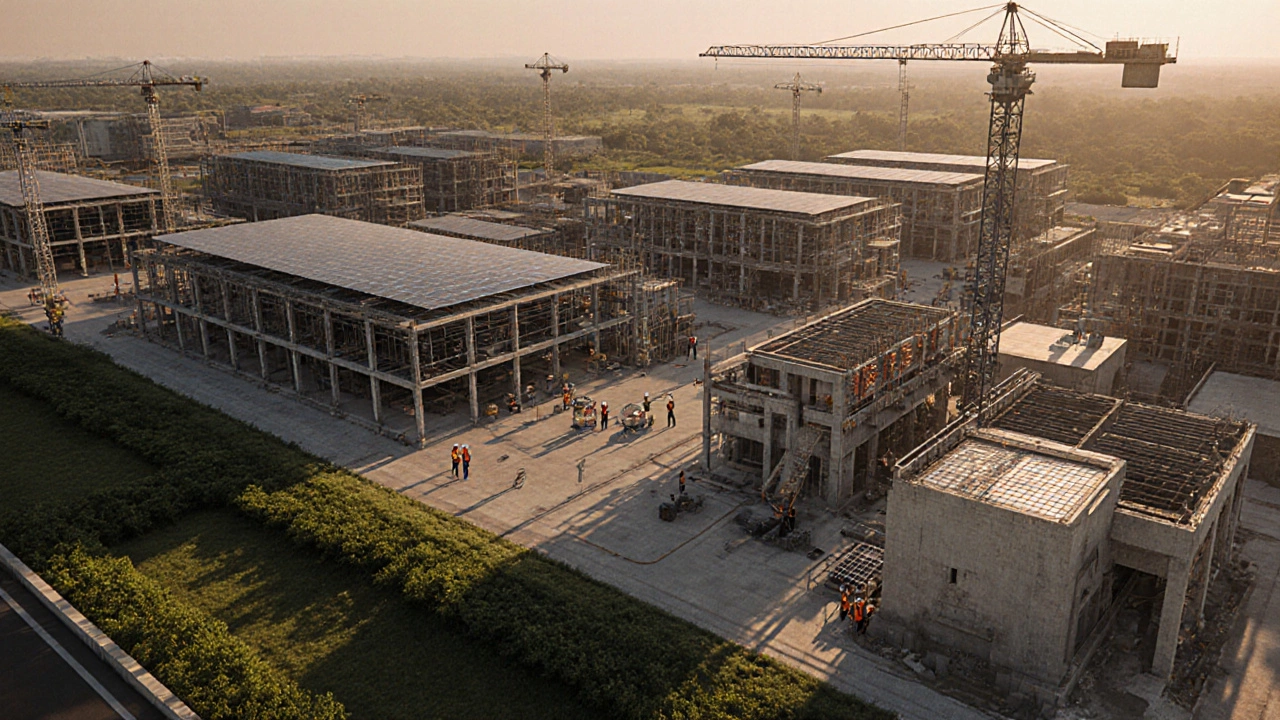Textile Policy Incentive Calculator
Calculate Your Potential Incentives
Estimate the financial support available under India's New Textile Policy (PLI Scheme)
Estimated Incentives
Note: Incentives are payable over 5 years if export growth meets minimum requirements.
India’s textile industry is the second-largest employer in the country after agriculture, supporting over 45 million people directly. But for years, manufacturers have struggled with outdated infrastructure, high energy costs, and stiff competition from Bangladesh, Vietnam, and China. That changed in 2024 with the launch of the New Textile Policy - a bold, ₹10,600 crore ($1.3 billion) government push to make India a global hub for textile production and exports.
What’s Actually New About This Policy?
The New Textile Policy, officially called the Production Linked Incentive (PLI) Scheme for Textiles, isn’t just another subsidy program. It’s a full-scale overhaul targeting three weak spots: manufacturing capacity, technology adoption, and global competitiveness.
Before 2024, India’s textile exports hovered around $40 billion annually. The goal now? $100 billion by 2030. To get there, the government is pouring money into five key areas:
- Building seven giant textile parks under the PM MITRA scheme
- Offering cash incentives for every rupee invested in advanced machinery
- Reducing power and logistics costs for exporters
- Boosting synthetic fiber and technical textile production
- Creating a single digital portal for approvals and subsidies
These aren’t vague promises. The PM MITRA parks - located in Madhya Pradesh, Telangana, Tamil Nadu, Uttar Pradesh, Andhra Pradesh, Karnataka, and Gujarat - are already under construction. Each park spans 1,000+ acres and includes power plants, water treatment units, common effluent treatment plants, and logistics hubs. Think of them as industrial cities built just for textiles.
Who Gets the Money and How?
The PLI scheme gives direct financial incentives based on incremental sales of manufactured goods. Here’s how it works in practice:
If you’re a textile manufacturer who invests ₹50 crore in new weaving or knitting machines, you can get up to 15% of that investment back as cash over five years - as long as your export sales grow by at least 10% year over year. The payout is tied to performance, not just spending. That’s different from old schemes that rewarded companies just for buying equipment.
Small and medium enterprises (SMEs) get extra support. A company with annual turnover under ₹500 crore gets a 20% higher incentive rate than large firms. This is meant to help family-run units and local mills upgrade without going broke.
Technical textiles - things like medical gauze, geotextiles for roads, bulletproof fabrics, and smart clothing - get special treatment. These high-value products used to be imported. Now, manufacturers who produce them get a flat ₹100 crore incentive for every ₹500 crore invested.
Why This Policy Is Different From Past Efforts
India has tried to boost textiles before. The 2017 Mega Textile Park scheme failed because parks were scattered, infrastructure was incomplete, and approvals took years. The 2021 PLI scheme for electronics worked because it focused on one thing: export growth. The textile policy learned from that.
This time, the government tied incentives to actual export numbers, not just production. They also fixed the broken approval system. Before, a manufacturer needed 17 different clearances from five ministries. Now, there’s one online portal - Textile e-Sewa - that handles everything from environmental clearances to tax exemptions. Applications are processed in 30 days, not 18 months.
Another big change: the policy pushes for automation. Many Indian mills still use 40-year-old looms. The new policy gives extra cash for buying digital looms, AI-powered quality control systems, and robotic fabric cutters. One mill in Surat upgraded 120 looms and cut labor costs by 30% in six months - and got ₹12 crore in incentives.

What This Means for Small Manufacturers
If you run a small weaving unit in Varanasi or a dyeing unit in Tiruppur, this policy isn’t just for big players. The government created a special sub-scheme called Textile Udyam for micro-enterprises.
Under Textile Udyam, a unit with fewer than 10 workers and an annual turnover under ₹5 crore can get:
- Up to ₹5 lakh in grants to replace manual machines with semi-automatic ones
- Free training in digital design and export documentation
- Access to shared testing labs for fabric quality checks
One woman-owned unit in Jaipur used this grant to buy a digital embroidery machine. They went from making 200 sarees a month to 1,200 - and now export to Germany and the UAE. Their turnover doubled in nine months.
Challenges Still Left Unresolved
It’s not all smooth sailing. Many small mills still don’t know about the scheme. The Ministry of Textiles ran 300 awareness camps in 2024, but rural areas still lag. Some manufacturers say the application process is too complex, even with the online portal.
Another issue: cotton prices. India produces 25% of the world’s cotton, but prices swing wildly. The policy doesn’t directly control cotton pricing, so mills still face input cost volatility. Some experts suggest the next phase should include a cotton futures exchange to stabilize prices.
Power supply remains a problem in states like Bihar and Jharkhand. Even with subsidies, unreliable electricity can shut down automated lines. The government says the PM MITRA parks will solve this with dedicated power grids - but those won’t be fully ready until 2027.

How This Compares to Global Competitors
China still dominates global textile exports with $300 billion annually. Bangladesh, with its low labor costs and free trade deals, exports $45 billion. Vietnam is catching up fast with modern factories and strong ties to the EU.
India’s advantage? It has the raw materials, the workforce, and now, the policy. But to compete, it needs to move faster. While Vietnam built 120 new textile factories between 2020 and 2024, India built 38. The new policy aims to change that - with 100 new mega units planned by 2028.
The real test? Will India become known for quality, not just cheap prices? The policy pushes for premium fabrics - organic cotton, recycled polyester, and high-end denim. Brands like Levi’s and H&M are already testing Indian suppliers under the new scheme.
What’s Next? The Road to 2030
The government plans to expand the policy in 2026 with two new additions:
- A Textile Export Credit Guarantee to help small exporters get financing
- A Green Textile Fund for solar-powered mills and zero-waste dyeing
By 2030, India wants 30% of its textile exports to come from technical textiles - up from just 5% today. That’s ambitious, but not impossible. If the current pace holds, India could hit $70 billion in exports by 2028.
The biggest winners? Manufacturers who act now. The incentives are time-bound. The PLI scheme runs until 2029. If you’re still using manual looms or haven’t applied for subsidies, you’re losing money.
This isn’t just about government aid. It’s about catching the next global wave. The world is moving away from fast fashion toward sustainable, locally made textiles. India has the people, the tradition, and now - the policy - to lead that shift.
What is the main goal of India's new textile policy?
The main goal is to boost India’s textile exports to $100 billion by 2030, up from $40 billion in 2023. It aims to make India a global manufacturing hub by improving infrastructure, encouraging automation, supporting small businesses, and promoting high-value technical textiles.
How much money is the government spending on this policy?
The government has allocated ₹10,600 crore (about $1.3 billion) for the new textile policy over five years. Most of this goes to the Production Linked Incentive (PLI) scheme, which gives cash back to manufacturers based on their export growth and investments in new machinery.
What is PM MITRA and how does it help textile manufacturers?
PM MITRA stands for Prime Minister’s Mega Integrated Textile Regions and Apparel. It’s a plan to build seven large textile parks across India, each with modern infrastructure like power, water treatment, and logistics hubs. These parks reduce costs for manufacturers by providing shared facilities and cutting down delays in approvals and supply chains.
Can small textile units benefit from this policy?
Yes. A special sub-scheme called Textile Udyam helps micro-enterprises with fewer than 10 workers. They can get up to ₹5 lakh in grants to buy semi-automatic machines, free training, and access to shared quality testing labs. Many small units have already doubled their output and started exporting.
What types of textiles are prioritized under this policy?
The policy gives extra incentives for technical textiles - like medical fabrics, geotextiles, automotive textiles, and smart clothing - as well as high-value products like organic cotton, recycled polyester, and premium denim. These have higher profit margins and less competition than basic cotton yarn.
When does the incentive program end?
The current PLI scheme runs until 2029. Manufacturers must invest and increase exports within this window to qualify for payouts. After that, the government may extend or replace it, but no guarantees exist beyond 2029.
How do I apply for subsidies under the new textile policy?
Apply through the Textile e-Sewa portal - a single online platform for all approvals and subsidy applications. You’ll need documents like your Udyam registration, bank details, machinery purchase invoices, and export records. Applications are reviewed in 30 days. The Ministry of Textiles also holds free workshops in major textile hubs like Surat, Tiruppur, and Ludhiana.
